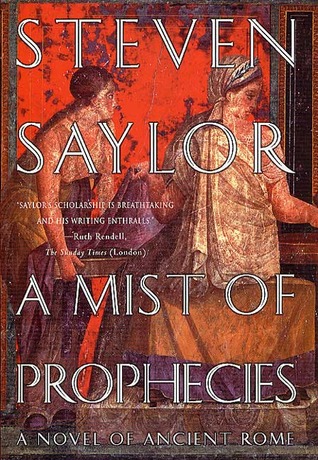I received this book for free from in exchange for an honest review. This does not affect my opinion of the book or the content of my review.

The House of the Vestals
by
Steven Saylor
It is part of the Roma Sub Rosa #6 series and is a historical mystery in Paperback edition that was published by Robinson on August 15, 1998 and has 272 pages.
Explore it on Goodreads or Amazon
Other books in this series include [books_series]
Other books by this author which I have reviewed include Arms of Nemesis, Seven Wonders, Catilina's Riddle, The Venus Throw, A Murder on the Appian Way, Rubicon, Last Seen in Massilia, A Mist of Prophecies
An anthology of nine short stories with one short story that takes place well before this book’s publication (as #6 in the series) and the other eight taking place between the first and the second in the Roma Sub Rosa ancient Roman mystery series.
Series:
“Death Wears a Mask”, 1.3
“The Tale of the Treasure House”, 1.2
“A Will is a Way”, 1.4
“The Lemures”, 1.5
“Little Caesar and the Pirates”, 1.6
“The Disappearance of the Saturnalia Silver”, 1.7
“King Bee and Honey”, 1.8
“The Alexandrian Cat”, 0.75
“The House of the Vestals”, 1.9
Lucius Claudius appears in most of the stories, and since he leaves his farm to Gordianus in Catilina’s Riddle, 3, well, you can read within the published line-up, but I’d recommend reading The House of the Vestals after Roman Blood, 1, and before Arms of Nemesis, 2, except for “The Alexandrian Cat”.
The Stories
“Death Wears a Mask” takes place four months after Roman Blood, 1, during Roman Festival with Gordianus treating Eco to his first theatre performance. One that definitely results in a performance, just a very unexpected one.
The play’s the thing, and so is murder. Nothing much has changed over the centuries. People are still greedy and quick to take advantage. It’s an intriguing look into a BC culture that reverberates with our own times. Impressive in how much the people of the time knew.
“The Tale of the Treasure House” is Bethesda’s story of a skinflint king who had the tables turned on him. By a woman, no less! It’s a familiar tale with a hint of the Scheherazade about it.
“A Will is a Way” is another twist on an old plot with friends deceiving another as they plan to help themselves to his fortune. It also brings Lucius Claudius into the series, and we learn how he and Gordianus become friends.
“The Lemures” could be scary…if you believed in ghosts…with an eyeopening ending. Simply a sad tale of greed while reminding us of the lawless state of Rome. There’s a cute side story that reminds us of the hazards of war and of Sulla’s actions in giancient Alexandria, cats, murders, family, betrayal, ving his soldiers farms as a reward.
“Little Caesar and the Pirates” springboards off a true story about Julius Caeser when he was kidnapped by pirates and his melodramatic “escape”. It’s another well-used plot that swayed between good and ho-hum. Its main claim to the reader’s interest is that it introduces Belbo into Gordianus’ household.
“The Disappearance of the Saturnalia Silver” is a quick peek into the day when custom is turned on its head and the masters serve the servants. A licentious holiday, it can backfire for some when a “theft” goes awry. Bethesda gets another opportunity to shine. This time as a detective with a slave’s insight. Although, I should have thought that peek would have been done after they found the body.
“King Bee and Honey” was a pip. It introduces us to Lucius’ farm as well as the Roman way with bees. We also get a backhanded glimpse into Lucius’ appreciation for Gordianus when unexpected, tony visitors descend upon them. A very clever, if unexpected murder.
“The Alexandrian Cat” is a narrow escape for one man when the cat-worshipping Alexandrians pursue a Roman merchant, intending to “execute” him for his murder of a cat. Another one of those interesting insights into an ancient culture as we tear through Alexandria at Gordianus’ side as he hopes to save a man.
Gordianus hasn’t yet met Bethesda. I must say that the Roman worship of paterfamilias is quite efficient.
“The House of the Vestals” gives us the background and details on the scandalous affair of Catilina being caught — after dark — in the bedroom of a Vestal Virgin. While we meet all the participants, it’s really Gordianus’ show, and he gives us reason to appreciate his thought processes.
The Cover and Title
My initial glimpse of the cover made me think medieval monk with the cowling of the foremost character while the figures in the background make me think more of a silly game as toga-clad men play hide-and-seek around the pillars and in the sewer while a Roman soldier steps forth, prepared to do battle. A collage of bits and pieces from the various stories: a Roman countryside, a frogless pond, and a man in blue will titillate your memories.
The title belongs to one of the stories within, a re-telling of Catilina’s adventures within The House of the Vestals.
















